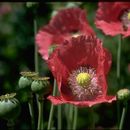Brief Summary
provided by EOL authors
Papaver somniferum, opium poppy, is an annual herbaceous plant in the Papaveraceae (poppy family) that originated in southeastern Europe and western Asia, and are now widely cultivated in Europe, Asia, China, and North Africa for their seeds, which are used in baking, as a condiment, and for their edible oil. It is also widely (and often illegally) cultivated for the production of opium, heroine, and morphine derived from the latex of the unripe fruit capsules. This species, along with numerous other Papaver species, is also planted as an ornamental for its attractive flowers and foliage. The opium poppy has a long history of cultivation and use in Central Asia and China—described in several recent nonfiction books—and is found primarily in cultivation or escaped from it. The plant grows to 1.5 m (4.5 ft) tall in cultivation, and has smooth or glaucous (waxy-coated) bluish-gray leaves, with coarse lobes or teeth. Leaves grow in a basal rosette; if a flowering stem develops, its (cauline) leaves are alternate. The flowers, which have 4 petals and many stamens, may be white, pink, purple, or red, are large, up to 10 cm (4 in) across, sometimes double. The fruit is a distinctive capsule, spherical or oblong, up to 9 cm (3.5 in) across, with small holes in the top. The capsule, which is green when it is forming and turns brown when mature, contains many seeds, typically black or deep gray seeds, although there is a white-seed cultivar from India. Poppy seeds are popular for pastries and baked goods in Turkey and Egypt, and are widely used in the regional cuisines of Central and Eastern Europe. They feature in typical Jewish holiday dishes. The seeds may be used whole, and are often sprinkled as a decorative topping on bagels and breads, or they may be ground into a paste (often sweetened with honey or sugar) and used as a filling. Ground poppy seeds are also used as a thickener in some Indian dishes. The oil extracted from poppy seeds can be used in cooking. The U.N. Food and Agriculture Organization (FAO) estimated that commercial production of poppy seeds (for food purposes) was 93,125 metrics tons in 2010, harvested from 142,220 hectares worldwide. Turkey and the Czech Republic were the leading producers, together accounting for 64% of the harvest. Spain, France, and Croatia each contributed another 5% or more of the total. The U.N. Office of Drugs and Crime (UNODC) estimated that the total area under opium poppy cultivation used in the illegal drug trade was 195,700 hectares in 2010, an increase of 5% from 2009 levels. The area cultivated in Afghanistan was 63% of the global total for both years; other major producers included Myanmar and Mexico. Despite the increase in area cultivated, production of opium declined to 4,860 metric tons (mt) in 2010 (from 7,754 mt in 2009) due to a widespread disease in Afghanistan’s poppy plants, but is projected to increase to previous levels. An estimated 460-480 mt of heroin was marketed in 2009, at a value of $68 billion U.S. dollars. (Bailey et al. 1976, Flora of China 2008, UNODC 2011, van Wyk 2005, Wikipedia 2012.)

